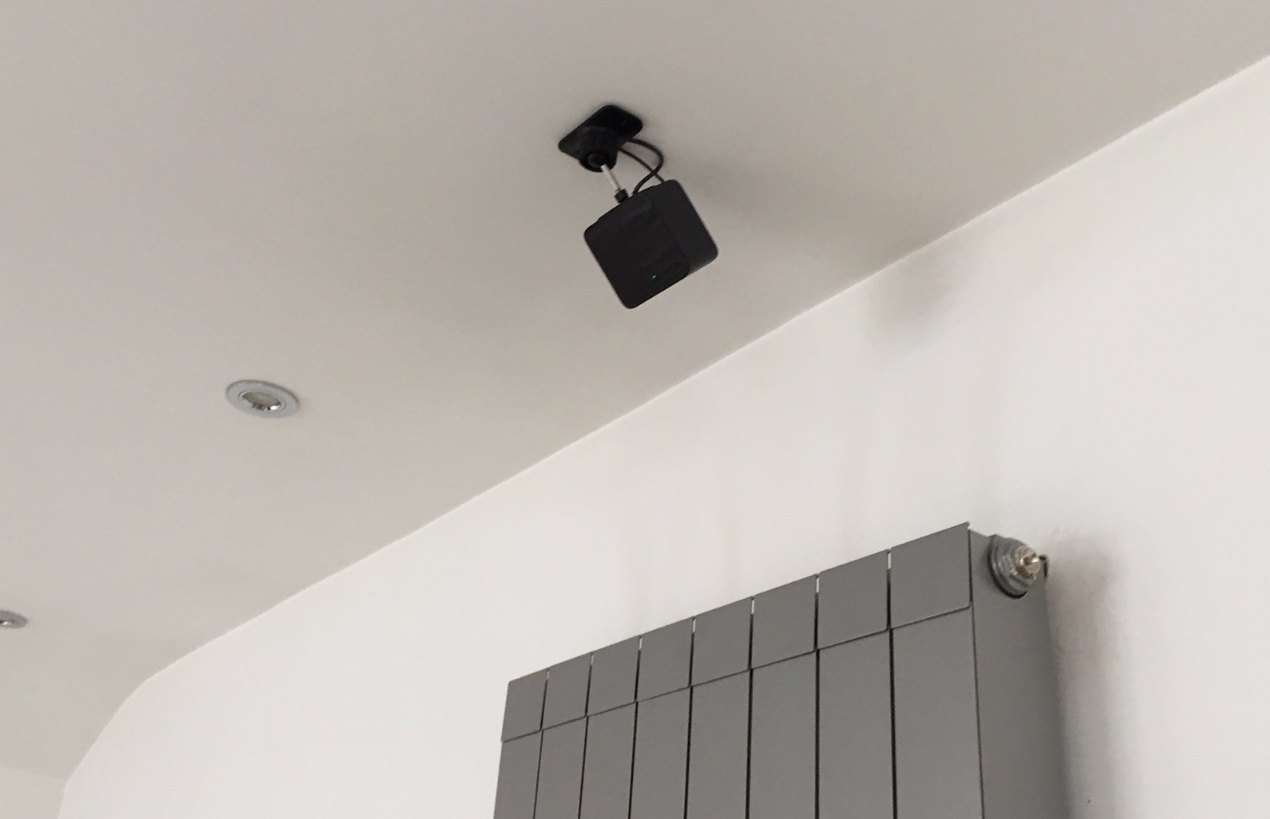I’ve had a vive in my office for a while. Not a new Vive, but the old kryten looking devkit. So when the preorder started for the proper version I decided I wanted to order one to put in the living room, with a computer in a drawer, that I could just close with it all inside when I’m not using it.
I thought I’d make a blog on how my setup went in the hopes that it helps other people’s setups go better.
Lighthouses
I put the lighthouses on the ceiling. I live in a bungalow so above the living room is loft. It was a simple 30 minute task to crawl around the loft, drill some holes for the wires, then attach the mounts to the ceiling.

This meant all the wires were nice and hidden. Just a shame they don’t make them in white – but they’re not that noticeable really.
One problem I ran into was that the TV remote didn’t work with them on. Well, it worked but I had to aim right at the sensor on the TV. With any other method you could probably manually walk over and switch them off, but because they’re plugged into a socket in the loft I couldn’t do that (without a wireless switcher).
Luckily if you enable bluetooth in the settings on the Vive it starts switching them off and on automatically when you start/stop steamvr. This could probably be made a little more obvious – since the only real way to learn about this is to switch it on for shits and gigs.
Mac Pro
I had a 2013 mac pro lying around that I planned to install Windows on and use as my living room VR computer. This worked, but ended up failing for two reasons.
It’s got an AMD Firepro D700. Which as far as I can tell doesn’t accept the latest generic amd drivers. The games that worked did work, and ran well. Some games, which I think were trying to go full screen, had trouble.
I think it was because the computer itself prioritized the hdmi slots wrong. Windows by default were opening on the Vive desktop. So games that were going full screen automatically were doing it on the vive screen – instead of the desktop screen – so the compositor or whatever couldn’t go full screen on the vive screen.
Also the displayport to HDMI I was using to connect it to the TV didn’t seem to carry sound. And I wanted to be able to have sound without earphones.
I decided that it wasn’t worth it, so I moved onto plan 2.
Alienware Steam Machine
For Christmas Facepunch gave everyone an alienware steam machine. I hadn’t really used mine up until now because I couldn’t be bothered to install windows on it, and the 10 games that ran on linux ran like shit. So this was an opportunity to use it.
It seemed like a perfect candidate. Decent performance, two hdmi slots (one for my tv, one for the vive), and small enough to fit in a drawer under the TV.
It was only after installing windows on it, updating all the graphics drivers and installing Steam that I realised that the second HDMI out was actually an HDMI in. So I’d totally wasted my time. So onto plan 3.
Laptop
I had a pretty powerful gaming laptop lying around, so I decided to use that. And it worked out quite well. I did run into some issues with SteamVR itself though.
When I first started playing with it the SteamVR complained that it couldn’t find the vive headset. The headset had a red light on the side. After about 30 minutes of plugging, unplugging, swapping hdmi cables, driver updates, I realised that the desktop size on the hdmi output was smaller than the max. After setting it to the max size it connected straight away.
I was happy to find out later that Direct Mode worked. I think it’s an nvidia thing, I couldn’t get it to work on the mac pro, but it gets rid of the second desktop so it’s just sending the pictures to the headset.. so it removes the possibility of a bunch of different fuckups.
After I got it working the headset kept losing tracking. I readjusted the lighthouses, cleaned their fronts, closed curtains. It had me thinking that the lasers were bouncing off the tv and fucking shit up, and I would have been throwing sheets over stuff if I hadn’t already had it tracking perfectly on the mac pro earlier. This is maybe the most frustrating thing with the vive right now. If it’s not tracking there’s no real way to find out why. You assume it’s something in the room – but it might not be that.
I found that it worked fine if I just sat in the grey liney room, but as soon as I pressed the steam menu button, when the overlay popped up it lost tracking and went into a connect, disconnect loop. I found some advice online that suggested disabling the camera – and that fixed it. I guess the 60fps camera overloads the usb bandwidth or something. I’m still not totally clear what limitation my laptop has that the mac pro hasn’t got, but while it’s working I don’t really want to fuck with it.
Summary
The biggest problem with the Vive right now is setting it up. Without any doubt at all. So its appeal is really going to be limited to people that know what they’re doing. That’s probably not a great surprise though.
The really great thing is that every time I use it I see that Valve have added a new option, or made it better in some other way. It’s very software orientated, so a lot of major stuff can be updated – so I imagine that most major gripes are in the process of being taken care of already.
It would be great if you didn’t need a monitor. If I could just plug it into a steam machine and press the button on the side of the hmd to open SteamVR.. and even if it’s not tracking there’d some kind of menu that I can somehow navigate to fix something, or diagnose something. I guess the market for that stuff is pretty limited because right now you’re showing it to people and want to see what you can see on the TV or something.


Add a Comment